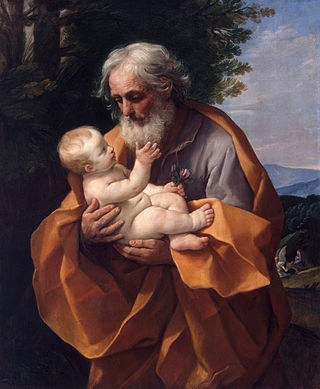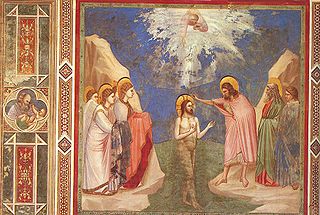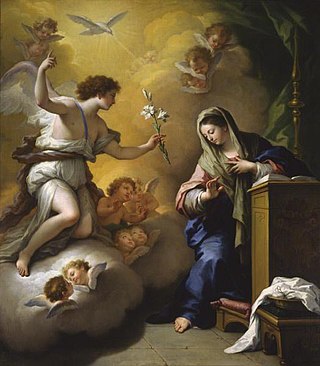
The liturgical year, also called the church year, Christian year or kalendar, consists of the cycle of liturgical seasons in Christian churches that determines when feast days, including celebrations of saints, are to be observed, and which portions of Scripture are to be read either in an annual cycle or in a cycle of several years.

Saint Joseph's Day, also called the Feast of Saint Joseph or the Solemnity of Saint Joseph, is in Western Christianity the principal feast day of Saint Joseph, husband of the Virgin Mary and legal father of Jesus Christ, celebrated on 19 March. It has the rank of a solemnity in the Catholic Church. It is a feast or commemoration in the provinces of the Anglican Communion, and a feast or festival in the Lutheran Church. Saint Joseph's Day is the Patronal Feast day for Poland as well as for Canada, persons named Joseph, Josephine, etc., for religious institutes, schools and parishes bearing his name, and for carpenters. It is also Father's Day in some Catholic countries, mainly Spain, Portugal, and Italy. It is not a holy day of obligation for Catholics in the United States.

Holy Week is the most sacred week in the liturgical year in Christianity. For all Christian traditions it is a moveable observance. In Eastern Christianity, which also calls it Great Week, it is the week following Great Lent and Lazarus Saturday, starting on the evening of Palm Sunday and concluding on the evening of Great Saturday. In Western Christianity, Holy Week is the sixth and last week of Lent, beginning with Palm Sunday and concluding on Holy Saturday.
A memorial in the Roman Rite of the Catholic Church is a lower-ranked feast day in honour of a saint, the dedication of a church, or a mystery of the religion.

In the Christian liturgical calendar, there are several different Feasts of the Cross, all of which commemorate the cross used in the crucifixion of Jesus. Unlike Good Friday, which is dedicated to the passion of Christ and the crucifixion, these feast days celebrate the cross itself, as the sign of salvation. In Western Catholicism, Eastern Catholicism, Eastern Orthodoxy, Oriental Orthodoxy, Lutheranism and Anglicanism the most common day of commemoration is 14 September, or 27 September in churches still using the Julian calendar.

The Feast of the Baptism of the Lord, or Theophany, is the feast day commemorating the baptism of Jesus in the Jordan River by John the Baptist. Originally the baptism of Christ was celebrated on Epiphany, which commemorates the coming of the Magi, the baptism of Christ, and the wedding at Cana. Over time in the West, however, the celebration of the baptism of the Lord came to be commemorated as a distinct feast from Epiphany. It is celebrated in the Catholic Church as well as the Anglican and Lutheran Churches on the first Sunday following The Epiphany of Our Lord. Some Lutheran churches celebrate it on the Sunday before Lent, or Quinquagesima.

The Feast of the Transfiguration is celebrated by various Christian communities in honor of the transfiguration of Jesus. The origins of the feast are less than certain and may have derived from the dedication of three basilicas on Mount Tabor. The feast was present in various forms by the 9th century, and in the Western Church was made a universal feast celebrated on 6 August by Pope Callixtus III to commemorate the raising of the siege of Belgrade (1456).

The Holy Family consists of the Child Jesus, the Virgin Mary and Saint Joseph. The subject became popular in art from the 1490s on, but veneration of the Holy Family was formally begun in the 17th century by Saint François de Laval, the first bishop of New France, who founded a confraternity.
This article lists the feast days of the General Roman Calendar as they were at the end of 1954. It is essentially the same calendar established by Pope Pius X (1903–1914) following his liturgical reforms, but it also incorporates changes that were made by Pope Pius XI (1922–1939), such as the institution of the Feast of Christ the King, and the changes made by Pope Pius XII (1939–1958) prior to 1955, chief among them the imposition of the Feast of the Immaculate Heart of Mary upon the universal Church in 1944, the inscription of Pius X into the General Calendar following his 1954 canonization, and the institution of the Feast of the Queenship of Mary in October 1954.

The Solemnity of Mary, the Holy Mother of God is a feast day of the Blessed Virgin Mary under the aspect of her motherhood of Jesus Christ, whom she had circumcised on the eighth day after his birth according to Levitical Law. Christians see him as the Lord and Son of God.

The Feast of the Annunciation, in Greek, Ο Ευαγγελισμός της Θεοτόκου, contemporarily the Solemnity of the Annunciation, and also called Lady Day, the Feast of the Incarnation, or Conceptio Christi, commemorates the visit of the archangel Gabriel to the Virgin Mary, during which he informed her that she would be the mother of Jesus Christ, the Son of God. It is celebrated on 25 March each year. In the Catholic Church, if 25 March falls during Holy Week, it is transferred forward to the first suitable day during Eastertide. In Eastern Orthodoxy and Eastern Catholicism, it is never transferred, even if it falls on Pascha (Easter). The concurrence of these two feasts is called Kyriopascha.

The Archdiocese of Chambéry, Saint-Jean-de-Maurienne, and Tarentaise is a Latin Church archdiocese of the Catholic Church in France and a suffragan of the Archdiocese of Lyon. The archepiscopal see is Chambéry Cathedral, located in the city of Chambéry. The archdiocese encompasses the department of Savoie, in the Region of Rhône-Alpes.
This article lists the feast days of the General Roman Calendar as approved on 25 July 1960 by Pope John XXIII's motu proprioRubricarum instructum and promulgated by the Sacred Congregation of Rites the following day, 26 July 1960, by the decree Novum rubricarum. This 1960 calendar was incorporated into the 1962 edition of the Roman Missal, continued use of which Pope Benedict XVI authorized in his 7 July 2007 motu proprio Summorum Pontificum, and which Pope Francis confirmed in his 16 July 2021 motu proprio Traditionis custodes, for use as a Traditional Roman Mass.

The Feast of the Most Precious Blood of Our Lord Jesus Christ was in the General Roman Calendar from 1849 to 1969. It was focused on the Blood of Christ and its salvific nature.
The Commemoration of the Passion of Christ was a feast of the Roman Catholic Church, listed in the Roman Missal up to 1962 as observed in some places, and kept on the Tuesday after Sexagesima. Its object is the devout remembrance and honour of Christ's sufferings for the redemption of mankind.

The Feast of the Crown of Thorns is a feast day of the Roman Catholic Church, for the Friday after Ash Wednesday. It is not universally observed.
The ranking of liturgical days in the Roman Rite is a regulation for the liturgy of the Roman Catholic church. It determines for each liturgical day which observance has priority when liturgical dates and times coincide, which texts are used for the celebration of the Holy Mass and the Liturgy of the hours and which liturgical color is assigned to the day or celebration.

The History of the Shroud of Turin begins in the year 1390 AD, when Bishop Pierre d'Arcis wrote a memorandum where he charged that the Shroud was a forgery. Historical records seem to indicate that a shroud bearing an image of a crucified man existed in the possession of Geoffroy de Charny in the small town of Lirey, France around the years 1353 to 1357. The history from the 15th century to the present is well documented.
Mysterii Paschalis is an apostolic letter issued motu proprio by Pope Paul VI on 14 February 1969. It reorganized the liturgical year of the Roman Rite and revised the liturgical celebrations of Jesus Christ and the saints in the General Roman Calendar. It promulgated the General Roman Calendar of 1969.

The Friday of Sorrows is a solemn pious remembrance of the sorrowful Blessed Virgin Mary on the Friday before Palm Sunday held in the fifth week of Lent. In the Anglican Ordinariate's Divine Worship: The Missal it is called Saint Mary in Passiontide and sometimes it is traditionally known as Our Lady in Passiontide.













